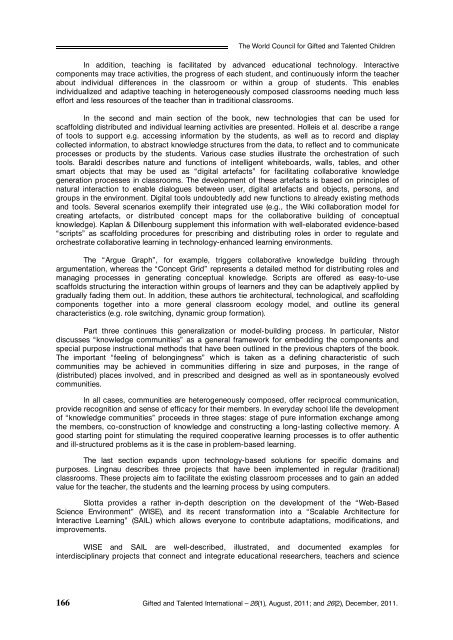The Journal of the World Council for Gifted and Talented Children
The Journal of the World Council for Gifted and Talented Children
The Journal of the World Council for Gifted and Talented Children
Create successful ePaper yourself
Turn your PDF publications into a flip-book with our unique Google optimized e-Paper software.
<strong>The</strong> <strong>World</strong> <strong>Council</strong> <strong>for</strong> <strong>Gifted</strong> <strong>and</strong> <strong>Talented</strong> <strong>Children</strong><br />
In addition, teaching is facilitated by advanced educational technology. Interactive<br />
components may trace activities, <strong>the</strong> progress <strong>of</strong> each student, <strong>and</strong> continuously in<strong>for</strong>m <strong>the</strong> teacher<br />
about individual differences in <strong>the</strong> classroom or within a group <strong>of</strong> students. This enables<br />
individualized <strong>and</strong> adaptive teaching in heterogeneously composed classrooms needing much less<br />
ef<strong>for</strong>t <strong>and</strong> less resources <strong>of</strong> <strong>the</strong> teacher than in traditional classrooms.<br />
In <strong>the</strong> second <strong>and</strong> main section <strong>of</strong> <strong>the</strong> book, new technologies that can be used <strong>for</strong><br />
scaffolding distributed <strong>and</strong> individual learning activities are presented. Holleis et al. describe a range<br />
<strong>of</strong> tools to support e.g. accessing in<strong>for</strong>mation by <strong>the</strong> students, as well as to record <strong>and</strong> display<br />
collected in<strong>for</strong>mation, to abstract knowledge structures from <strong>the</strong> data, to reflect <strong>and</strong> to communicate<br />
processes or products by <strong>the</strong> students. Various case studies illustrate <strong>the</strong> orchestration <strong>of</strong> such<br />
tools. Baraldi describes nature <strong>and</strong> functions <strong>of</strong> intelligent whiteboards, walls, tables, <strong>and</strong> o<strong>the</strong>r<br />
smart objects that may be used as “digital artefacts” <strong>for</strong> facilitating collaborative knowledge<br />
generation processes in classrooms. <strong>The</strong> development <strong>of</strong> <strong>the</strong>se artefacts is based on principles <strong>of</strong><br />
natural interaction to enable dialogues between user, digital artefacts <strong>and</strong> objects, persons, <strong>and</strong><br />
groups in <strong>the</strong> environment. Digital tools undoubtedly add new functions to already existing methods<br />
<strong>and</strong> tools. Several scenarios exemplify <strong>the</strong>ir integrated use (e.g., <strong>the</strong> Wiki collaboration model <strong>for</strong><br />
creating artefacts, or distributed concept maps <strong>for</strong> <strong>the</strong> collaborative building <strong>of</strong> conceptual<br />
knowledge). Kaplan & Dillenbourg supplement this in<strong>for</strong>mation with well-elaborated evidence-based<br />
“scripts” as scaffolding procedures <strong>for</strong> prescribing <strong>and</strong> distributing roles in order to regulate <strong>and</strong><br />
orchestrate collaborative learning in technology-enhanced learning environments.<br />
<strong>The</strong> “Argue Graph”, <strong>for</strong> example, triggers collaborative knowledge building through<br />
argumentation, whereas <strong>the</strong> “Concept Grid” represents a detailed method <strong>for</strong> distributing roles <strong>and</strong><br />
managing processes in generating conceptual knowledge. Scripts are <strong>of</strong>fered as easy-to-use<br />
scaffolds structuring <strong>the</strong> interaction within groups <strong>of</strong> learners <strong>and</strong> <strong>the</strong>y can be adaptively applied by<br />
gradually fading <strong>the</strong>m out. In addition, <strong>the</strong>se authors tie architectural, technological, <strong>and</strong> scaffolding<br />
components toge<strong>the</strong>r into a more general classroom ecology model, <strong>and</strong> outline its general<br />
characteristics (e.g. role switching, dynamic group <strong>for</strong>mation).<br />
Part three continues this generalization or model-building process. In particular, Nistor<br />
discusses “knowledge communities” as a general framework <strong>for</strong> embedding <strong>the</strong> components <strong>and</strong><br />
special purpose instructional methods that have been outlined in <strong>the</strong> previous chapters <strong>of</strong> <strong>the</strong> book.<br />
<strong>The</strong> important “feeling <strong>of</strong> belongingness” which is taken as a defining characteristic <strong>of</strong> such<br />
communities may be achieved in communities differing in size <strong>and</strong> purposes, in <strong>the</strong> range <strong>of</strong><br />
(distributed) places involved, <strong>and</strong> in prescribed <strong>and</strong> designed as well as in spontaneously evolved<br />
communities.<br />
In all cases, communities are heterogeneously composed, <strong>of</strong>fer reciprocal communication,<br />
provide recognition <strong>and</strong> sense <strong>of</strong> efficacy <strong>for</strong> <strong>the</strong>ir members. In everyday school life <strong>the</strong> development<br />
<strong>of</strong> “knowledge communities” proceeds in three stages: stage <strong>of</strong> pure in<strong>for</strong>mation exchange among<br />
<strong>the</strong> members, co-construction <strong>of</strong> knowledge <strong>and</strong> constructing a long-lasting collective memory. A<br />
good starting point <strong>for</strong> stimulating <strong>the</strong> required cooperative learning processes is to <strong>of</strong>fer au<strong>the</strong>ntic<br />
<strong>and</strong> ill-structured problems as it is <strong>the</strong> case in problem-based learning.<br />
<strong>The</strong> last section exp<strong>and</strong>s upon technology-based solutions <strong>for</strong> specific domains <strong>and</strong><br />
purposes. Lingnau describes three projects that have been implemented in regular (traditional)<br />
classrooms. <strong>The</strong>se projects aim to facilitate <strong>the</strong> existing classroom processes <strong>and</strong> to gain an added<br />
value <strong>for</strong> <strong>the</strong> teacher, <strong>the</strong> students <strong>and</strong> <strong>the</strong> learning process by using computers.<br />
Slotta provides a ra<strong>the</strong>r in-depth description on <strong>the</strong> development <strong>of</strong> <strong>the</strong> “Web-Based<br />
Science Environment” (WISE), <strong>and</strong> its recent trans<strong>for</strong>mation into a “Scalable Architecture <strong>for</strong><br />
Interactive Learning” (SAIL) which allows everyone to contribute adaptations, modifications, <strong>and</strong><br />
improvements.<br />
WISE <strong>and</strong> SAIL are well-described, illustrated, <strong>and</strong> documented examples <strong>for</strong><br />
interdisciplinary projects that connect <strong>and</strong> integrate educational researchers, teachers <strong>and</strong> science<br />
166 <strong>Gifted</strong> <strong>and</strong> <strong>Talented</strong> International – 26(1), August, 2011; <strong>and</strong> 26(2), December, 2011.


